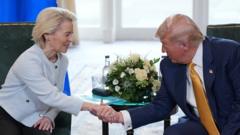Will the New EU-US Trade Deal with 15% Tariffs Boost Exports?

The Recent Trade Deal Between the United States and the European Union
In a significant development that promises to reshape economic relations between two of the world’s most influential trading partners, the United States and the European Union have struck a trade deal. This agreement marks the end of a prolonged standoff that had raised concerns about the future of transatlantic trade. After extensive negotiations led by President Donald Trump and European Commission President Ursula Von der Leyen, both parties have agreed to a tariff structure aimed at fostering stability and enhancing trade flows. This article delves into the details of the deal, its implications for trade between the US and the EU, and the broader context of global economics.
The Key Elements of the Trade Agreement
At the heart of the trade deal is a comprehensive agreement that outlines specific tariff rates and commitments from both sides. The US will impose a 15% tariff on all EU goods, which is significantly lower than the 30% rate that President Trump had initially threatened. This compromise reflects a strategic negotiation that seeks to balance protectionism with a desire for mutual economic benefit.
In return, the European Union has committed to removing tariffs on various American products, which is expected to boost US exports significantly. This reciprocal arrangement is aimed at enhancing market access and creating a more favorable trade environment for American goods.
Investments and Economic Growth
Another crucial aspect of the agreement involves a substantial commitment from the EU to invest in the US economy. President Trump announced that the EU would increase its investment in the US by $600 billion (£446 billion). This investment is anticipated to cover a range of sectors, including military equipment, energy infrastructure, and more.
- Military Equipment: The EU is expected to purchase hundreds of billions of dollars in US military equipment, further solidifying defense ties.
- Energy Sector: A commitment of $750 billion towards energy will focus on liquefied natural gas and other energy resources, which should help lessen European reliance on Russian energy supplies.
The Economic Landscape: Trade Imbalance and Tariff Revenue
The trade relationship between the US and the EU is substantial. In the previous year, trade in goods amounted to approximately $975.9 billion. The US imported around $606 billion in goods from the EU while exporting about $370 billion, resulting in a notable trade deficit for the US. This trade imbalance has been a focal point for President Trump, who views it as detrimental to American economic interests.
With the newly established 15% tariff, the US government expects to generate approximately $90 billion in tariff revenue, based on last year’s trade figures. This revenue could potentially bolster government coffers and provide funds for domestic initiatives.
The Strategic Importance of the Deal
Both the US and the EU can present this trade deal as a triumph. For the EU, the final tariff rate could have been significantly worse, especially in comparison to the UK's 10% tariff rate. The 15% tariff aligns with the rate Japan negotiated, allowing the EU to navigate a challenging negotiation landscape without incurring heavier penalties.
For the United States, this agreement represents not only a strategic win in terms of tariff revenue but also a substantial influx of foreign investment. The anticipated $600 billion investment is poised to stimulate various sectors of the American economy, further enhancing growth opportunities.
Potential Challenges and Future Implications
Despite the positive outlook, challenges remain. President Trump has maintained a 50% tariff on steel and aluminum imports globally, which could complicate relations with trading partners. Additionally, there is the lingering threat of retaliatory tariffs from the EU on American exports, particularly in sectors vital to the US economy, such as automotive and agricultural products.
Moreover, the broader geopolitical context cannot be ignored. The US’s approach to trade has been characterized by a desire to reshape global economic relations, which includes negotiating with other partners such as the UK, Japan, Indonesia, and Vietnam. The effectiveness of these negotiations will play a crucial role in the US's ability to achieve its goals of reducing trade deficits and bolstering domestic industries.
Conclusion
The recent trade deal between the United States and the European Union signifies a pivotal moment in transatlantic relations. By agreeing on tariff rates and investment commitments, both sides have taken a step towards a more stable and productive economic partnership. As these changes unfold, the implications will be felt not only in the US and EU but across the global economy.
As we look ahead, the effectiveness of this agreement will depend on the cooperation and commitment of both parties to uphold the terms and foster an environment conducive to trade and investment. The future of US-EU relations remains a critical element in the broader context of international trade dynamics.
FAQs
What are the main components of the US-EU trade deal?
The agreement includes a 15% tariff on EU goods, the removal of tariffs on certain US products by the EU, and a commitment from the EU to invest $600 billion in the US economy.
How will the trade deal affect the US economy?
The deal is expected to generate approximately $90 billion in tariff revenue and bolster sectors such as military and energy through significant foreign investment.
What are the potential challenges following this trade agreement?
Challenges include existing global tariffs on steel and aluminum, the possibility of retaliatory tariffs from the EU, and the need to maintain favorable relations with other trading partners.
As the global economic landscape continues to evolve, how do you think this trade deal will influence future negotiations with other countries? #TradeDeal #USEURelations #GlobalEconomy
Published: 2025-07-27 20:27:02 | Category: world



